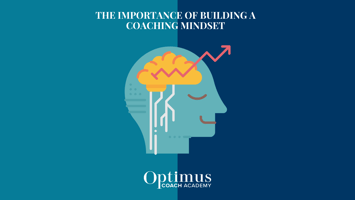Right now it feels like we're in a period of uncertainty, rapid technological change and more...
Simplification reduces stress
This month is Stress Awareness Month. Stress and poor mental health are one of the biggest public health challenges that we’re facing in the UK. Stress Awareness Month has been held every April since 1992 to raise awareness of the causes and cures for our modern-day stress epidemic.
Before we delve into this blog, ask yourself; what is ONE thing you can do to reduce your stress levels right now? - This is a great question to continually ask yourself.
Understanding the brain helps us become more effective as coaches. For example: when we’re stressed, cortisol levels leap up and we find it difficult to make decisions.
As the Founder and CEO of Optimus, I’m very aware of how my stress levels impact my ability to think and make decisions. And how it can affect the way I interact with others. My goal is always to continually develop and model good stress behaviours. To do this, I let people know it’s OK to take a break, nurture their brains and spend time offline. Most of the time, I think I model these behaviours well. But I’m not perfect…
If I notice that my diary is getting full. I take a step back and asked myself: ‘what are my priorities?’ and ‘how could I be more effective here?’ The answer? Stepping away from my business in the short term, so I have capacity to lead and manage effectively. Simplification reduces stress!
As coaches, entrepreneurs and business leaders, we need to work on reducing our stress levels. By keeping our stress levels down, we can show up and deliver effective coaching.
If a client is stressed, we need to lower those stress levels BEFORE we continue, or the coaching won’t be as effective. Consider what can you do as a coach to reduce your client’s stress levels?
Here are some ways to lower stress levels:
- Stop and breathe! Whatever you’re doing, stop and take some deep breaths – in through your nose and out through your mouth. You can even try something like box breathing/square breathing– breathe in for four, hold for four, exhale for four and hold for four… and repeat. This technique distracts the mind as you count; it relaxes you and calms the nervous system, and decreases stress in your body. Studies show that regulating your breath can lower levels of the stress hormone cortisol and maybe even help lower blood pressure.
- Address Your Stress Bucket - Ask, what can you remove from your stress bucket? This is a great tool you can use yourself and with clients to manage stress levels... Imagine there’s a bucket inside your body, collecting every ounce of your stress. Each day, your bucket is filled with smaller events, day-to-day things and bigger events. It can be near-empty one day, and full the other. What goes into your bucket boils down to how you feel about events and situations. Sometimes, we have so much going on that our buckets overflow. If this is you today, have a look at what you can take out. What can you take out of your bucket? It could be answering emails, getting the laundry done… What is it for you?
- Boundaries - Setting boundaries is essential for our wellbeing. But how can we set them effectively? Is there a right or wrong way to set a boundary? You don’t need to apologise or over explain - if you do, people will think you’re doing something wrong - but you’re not. Setting boundaries is a reasonable thing to do. Always be direct and clear when communicating that you can’t do something. Don’t worry if people aren’t happy about it - people may respond negatively to you setting boundaries, but don’t feel guilty. Some people take advantage of a lack of boundaries and might not enjoy your decision to protect yourself. Remember, this is about your wellbeing! Remind yourself this is an act of self-love - we set boundaries to limit our exposure to stress. Setting boundaries is a healthy act and something you should never feel guilty about doing. Have a post-boundary setting mantra, such as; ‘I’m doing this because I care about myself.’
- Imagine Connecting to Yourself Without Stress - This version of you is floating in a pool of calm. Take some time to picture yourself in this state. What are you thinking? What are you feeling? How are you behaving? What’s different? If you imagined yourself to be a calm person, what would change right now? What would you NO LONGER do? What would you do MORE of? Why does this work? Visualisation is the first step to building a new neural pathway in your brain, creating a calmer you. What can you do now to reinforce this pathway?
- Stressor Signs and Coping Mechanisms - We know that stress levels are impacted by many different variables in life and so, it’s important to; understand more about stress, recognise your own stressor signs and find coping mechanisms that work for you. Revisit a time you felt stressed before and apply the stress-reduction strategy that helped you. Stress isn’t avoidable, but it can be managed.



